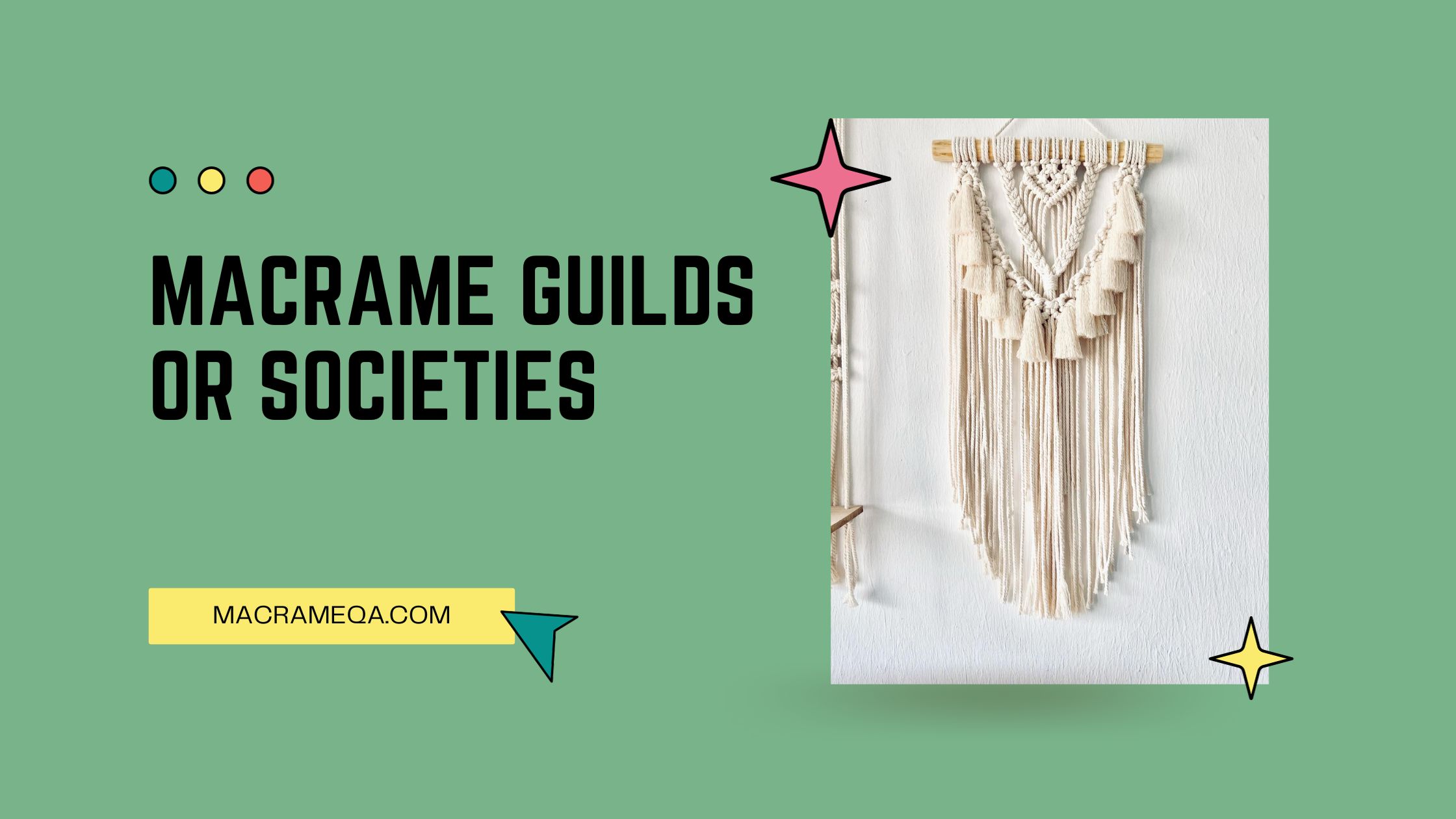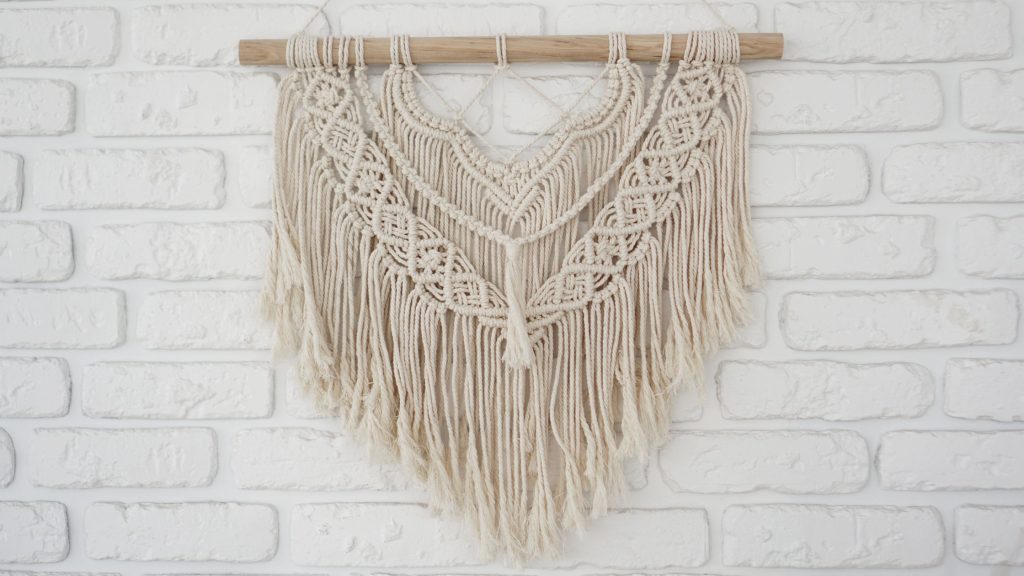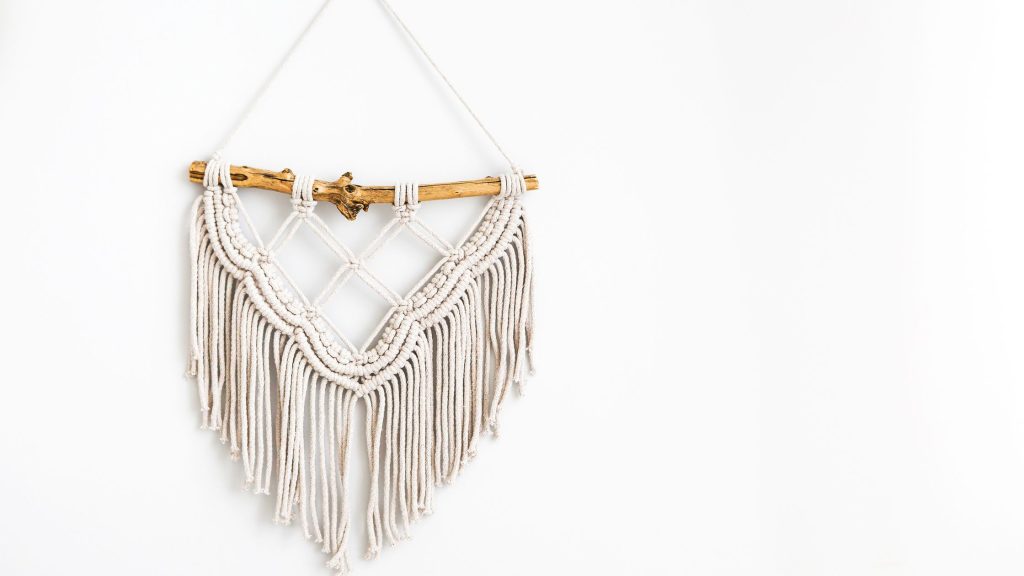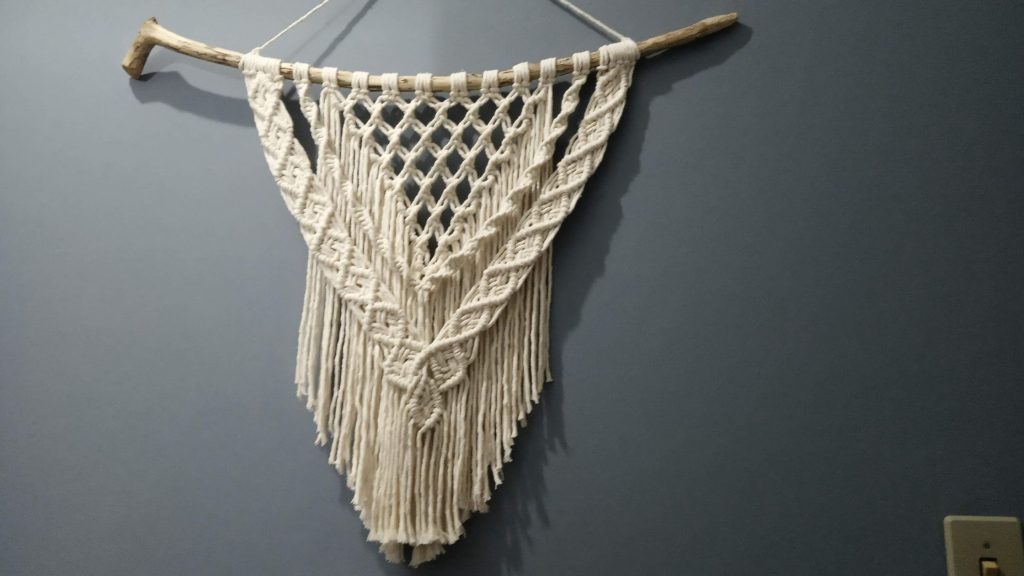If you’ve ever wondered about the origins and rich history of macrame, you might find yourself asking, “Were there any historical macrame guilds or societies?” Delving into the fascinating past of this intricate art form, you’ll be delighted to discover that macrame has indeed taken on a collective spirit throughout the ages. From ancient civilizations to modern times, the world of macrame has been nurtured by dedicated craftsmen and women who formed guilds and societies to share their knowledge, techniques, and passion for this captivating craft. In this article, we will embark on a journey through time to explore the existence of these historical macrame communities and the profound influence they’ve had on shaping the art we know and love today.
What is Macrame?
Macrame is the art of knotting ropes or cords together to create various decorative and functional items. It is a versatile craft that allows for intricate designs and patterns to be formed solely by using different knotting techniques. Macrame is often used to create wall hangings, plant hangers, jewelry, and even clothing. The beauty of macrame lies in its ability to transform simple materials into stunning and unique creations.
Definition
Macrame is derived from the Arabic word “migramah,” which means “fringe.” This aptly describes the technique of macrame, as it involves creating decorative fringes, knots, and patterns using various types of knotting techniques. Macrame has been practiced for centuries in various cultures, including the Arab, Turkish, and Chinese civilizations. Over time, it spread to different parts of the world and evolved into the art form known today.
Origin and History
The origins of macrame can be traced back to ancient times. The craft is believed to have originated in the Middle East, where the knotting technique was used to create decorative fringes on garments and textiles. From there, macrame spread to different parts of the world through trade routes and exploration. In the 13th century, Arab weavers used macrame techniques to create intricate tapestries known as “Migramahs.”
During the Renaissance period, macrame gained popularity in Europe, particularly in Italy and France. It was used to create elaborate lace trimmings for clothing and furnishings. Macrame continued to flourish in the 19th and 20th centuries, becoming a popular craft in America and other parts of the world. Today, macrame is experiencing a resurgence, with modern artisans putting their unique twist on traditional techniques.
The Emergence of Macrame Guilds and Societies
The Importance of Guilds and Societies
Macrame guilds and societies play a crucial role in preserving the art of macrame and promoting its continued practice. These organizations provide a platform for macrame enthusiasts to come together, share their knowledge, and collaborate on projects. By creating a sense of community, guilds, and societies ensure that the techniques and techniques of macrame are passed down from generation to generation.
Macrame Guilds in Europe
Europe has a rich history of macrame guilds, with many of them dating back centuries. These guilds served as centers of learning and craftsmanship, where members would gather to exchange ideas, techniques, and patterns. They played a vital role in preserving and advancing the art of macrame throughout Europe.
Some notable macrame guilds in Europe include the Guild of the Lime Tree in Germany, the Guild of the Pinks and Tulips in the Netherlands, and the Guild of Saint John in France. These guilds often organized exhibitions, workshops, and competitions to showcase the skills and creativity of their members.
Macrame Societies in the United States
In the United States, macrame societies emerged in the late 20th century as a response to the growing interest in the craft. These societies provided a platform for macrame artists and enthusiasts to come together, learn from each other, and promote the art form to a wider audience.
One of the earliest macrame societies in the United States was the American Macrame Association, founded in the 1970s. This organization played a significant role in popularizing macrame and organizing exhibitions and workshops across the country. Over time, more macrame societies emerged, each with its own unique focus and contributions to the craft.
Significance of Macrame Guilds and Societies
Preservation of Macrame Techniques
One of the primary roles of macrame guilds and societies is to preserve the traditional techniques and knowledge of macrame. Through workshops, classes, and demonstrations, members can learn from experienced practitioners and master craftsmen. This ensures that the intricate knotting techniques and patterns are passed down through the generations, keeping the art form alive and thriving.
Promotion and Education
Macrame guilds and societies actively promote the craft to a wider audience by organizing exhibitions, fairs, and competitions. These events provide an opportunity for macrame artists to showcase their work and inspire others to take up the craft. Additionally, guilds and societies often publish newsletters or magazines, sharing tips, patterns, and stories from the macrame community, further spreading awareness and knowledge.
Networking and Collaboration
By joining a macrame guild or society, members gain access to a network of fellow enthusiasts, artisans, and suppliers. This network allows for collaboration on projects, sharing of resources and ideas, and fostering a sense of camaraderie and support within the macrame community. It creates opportunities for learning and growth, as members can learn from each other’s experiences and expertise.
Prominent Macrame Guilds and Societies
International Organization of Lace, Inc.
The International Organization of Lace, Inc. (IOLI) is a renowned macrame guild that focuses on various lace-making techniques, including macrame. Founded in 1952, IOLI brings together lace enthusiasts from around the world and provides resources, workshops, and exhibitions to promote and preserve the art of lace and macrame.
Handweavers Guild of America
While primarily focused on handweaving, the Handweavers Guild of America (HGA) also encompasses other fiber arts, including macrame. This organization supports fiber artists and craftsmen through education, exhibitions, and publications. Its membership provides opportunities for macrame artists to connect with a broader community and gain exposure to their work.
British Tapestry Group
The British Tapestry Group (BTG) is a prestigious society that promotes and advances the art of tapestry weaving, including macrame techniques. Founded in 1990, BTG provides a platform for tapestry artists to exchange ideas, exhibit their work, and create opportunities for learning and collaboration.
Contemporary Fiber Artists of Louisiana
The Contemporary Fiber Artists of Louisiana (CFAL) is a regional guild that focuses on contemporary fiber art, including macrame. This organization aims to educate, inspire, and mentor artists working with various fiber techniques. CFAL regularly organizes exhibitions and workshops, showcasing the talent of its members and fostering a sense of community within Louisiana’s fiber art scene.
Membership and Benefits
Requirements for Membership
The requirements for membership in macrame guilds and societies vary from organization to organization. Typically, individuals interested in joining will need to complete an application, pay annual dues, and adhere to the organization’s code of conduct. Some guilds may require a demonstration of basic macrame skills or a portfolio of work to be considered for membership.
Benefits of Joining
Joining a macrame guild or society offers numerous benefits to members. Firstly, it provides access to a supportive community of fellow macrame enthusiasts who share a passion for the craft. This network allows for the sharing of knowledge, resources, and inspiration.
Additionally, guild membership often includes access to workshops, classes, and demonstrations led by experienced artists. These opportunities for learning and skill-building can greatly enhance one’s macrame abilities and open up new creative possibilities.
Furthermore, being part of a guild or society often grants members the chance to participate in exhibitions, fairs, and competitions. These events provide a platform to showcase and sell their work, gain recognition, and connect with a wider audience.
Activities and Events Organized
Macrame guilds and societies organize a wide range of activities and events throughout the year. These include workshops, classes, and demonstrations where members can learn new techniques, refine their skills, and exchange ideas. Guilds also host exhibitions, fairs, and competitions, allowing artists to exhibit and sell their work.
Additionally, guilds may arrange guest lectures, artist talks, and studio visits to provide members with insight into the broader world of macrame and fiber arts. Social events, such as group outings or gatherings, are also organized to foster a sense of community and camaraderie among members.
Challenges and Evolution
Challenges Faced by Macrame Guilds and Societies
Macrame guilds and societies face several challenges in today’s rapidly changing world. One of the main challenges is attracting and retaining younger members. As traditional crafting skills compete with the allure of modern technology, it can be difficult to engage younger generations and spark their interest in macrame.
Another challenge is the availability of resources and materials. With the globalization of trade, many traditional macrame materials have become scarce or expensive, causing artisans to seek alternative options. Guilds and societies need to constantly adapt and find innovative solutions to keep the craft accessible and affordable for their members.
Adapting to Modern Times
To address the challenges of staying relevant in the modern world, macrame guilds and societies are embracing technology and social media. Many organizations maintain an online presence, using websites, social media platforms, and online forums to connect with their members and reach a wider audience.
The use of technology allows guilds to offer online classes, tutorials, and resources, making macrame more accessible to those who cannot attend in-person events. It also provides a platform for showcasing and promoting the work of guild members, increasing their visibility in the online craft community.
Influence of Online Communities
Alongside traditional guilds and societies, online communities dedicated to macrame have emerged. Social media platforms, online forums, and websites provide spaces for macrame enthusiasts to connect, share ideas, and seek inspiration.
While online communities cannot fully replicate the sense of community and shared experience found in physical guilds, they offer a valuable platform for learning, collaboration, and support. Online tutorials, virtual workshops, and discussions contribute to the growth and evolution of macrame as a craft.
Legacy and Future Prospects
Preserving Traditional Macrame
Macrame guilds and societies have a vital role in preserving the traditional techniques and patterns of macrame. By providing education, resources, and networking opportunities, these organizations ensure that the craft continues to be passed down through the generations. Preserving traditional macrame techniques ensures that the art form remains alive and connected to its rich history.
Exploring New Horizons
While traditional macrame techniques hold great significance, guilds and societies also encourage experimentation and innovation within the craft. By exploring new horizons and pushing the boundaries of what can be achieved with macrame, artists can breathe new life into the art form and attract new audiences.
In recent years, macrame has expanded beyond its traditional applications, with artists creating large-scale installations, contemporary sculptures, and even fine art pieces using macrame techniques. By embracing new materials, technologies, and concepts, macrame evolves and remains relevant in the ever-changing world of art and design.
Interest and Enthusiasm among Younger Generations
Despite the challenges faced by macrame guilds and societies in attracting younger members, there is a growing interest and enthusiasm among younger generations for the craft. As more individuals seek sustainable and handmade alternatives to mass-produced items, macrame offers a unique and creative outlet.
The resurgence of interest in DIY and crafting, coupled with the popularity of vintage and bohemian aesthetics, has fueled the revival of macrame. Additionally, the meditative and therapeutic aspects of knotting and creating intricate patterns are appealing to those seeking a mindful and calming activity.
Macrame guilds and societies can tap into this growing interest by offering tailored programs and events that cater to the needs and preferences of younger members. By embracing modern trends and adapting to the changing landscape of the craft, guilds can ensure a vibrant and diverse macrame community for years to come.
Uncovering Historical Macrame Guilds and Societies
Research and Documentation
Uncovering the history of macrame guilds and societies requires extensive research and documentation. Many historical records and artifacts related to macrame have been lost over time, making it challenging to piece together a comprehensive history. Researchers and enthusiasts often rely on written accounts, paintings, tapestries, and other visual evidence to gain insights into the practices and techniques of macrame guilds in the past.
Historical Records and Artifacts
Despite the challenges, there are still historical records and artifacts that provide valuable information about macrame guilds and societies. Books, manuscripts, and journals from different time periods contain descriptions and illustrations of macrame techniques, patterns, and the activities of guilds. Additionally, preserved garments, tapestries, and textile fragments offer insights into the skill and craftsmanship of macrame artisans.
Archives and collections in museums, libraries, and historical societies are also important sources of information for researchers. They can provide access to original documents, photographs, and objects related to macrame guilds and societies, contributing to a deeper understanding of their significance in history.
Accounts of Macrame Artists and Craftsmen
Personal accounts and narratives of macrame artists and craftsmen from different eras can shed light on the practices and experiences of guilds and societies. These accounts offer a glimpse into the daily lives of macrame artisans, their challenges, successes, and the impact of guilds on their craft.
Historical documents, letters, and interviews with descendants of macrame artists can provide firsthand accounts of guild activities, collaborations, and the role of guilds in supporting and promoting macrame as an art form. Uncovering and preserving these oral histories and personal stories is essential for understanding the legacy and impact of macrame guilds and societies.
Macrame Guilds in Europe
Origins and Development
Macrame guilds in Europe have a long and storied history that spans centuries. The craft gained significant popularity during the Renaissance period, especially in Italy and France, where it was used to create intricate lace trimmings for garments and furnishings.
Over time, macrame guilds evolved and adapted to the changing artistic and cultural landscape. They embraced new techniques, materials, and styles, reflecting the influence of different artistic movements and socio-political changes. Macrame guilds became centers of innovation and creativity, pushing the boundaries of what could be achieved with knotting techniques.
Prominent European Macrame Guilds
Several prominent European macrame guilds have made significant contributions to the development and promotion of the craft. The Guild of the Lime Tree in Germany has a centuries-old tradition of macrame, focusing on creating intricate lace trims and edgings that are still cherished and sought after today.
In the Netherlands, the Guild of the Pinks and Tulips played a vital role in preserving and advancing macrame techniques. This guild specializes in creating elaborate macrame designs for clothing and textiles, incorporating floral motifs and patterns inspired by nature.
France has been home to various macrame guilds, with the Guild of Saint John being one of the most notable. This guild focused on macrame as a form of lace-making, creating stunning tapestries, tablecloths, and clothing embellishments using intricate knotting techniques.
Exhibitions and Events
Macrame guilds in Europe have a rich tradition of organizing exhibitions and events to showcase the talent of their members and promote the craft to a wider audience. These exhibitions often feature a wide range of macrame creations, from small accessories to larger wall hangings and installations.
Alongside exhibitions, macrame guilds organize workshops, classes, and demonstrations to educate and inspire both novice and experienced macrame enthusiasts. These events provide invaluable opportunities to learn from master artisans, refine techniques, and gain exposure to new ideas and styles.
Conclusion
The historical macrame guilds and societies have played a crucial role in the preservation, promotion, and development of the craft. Through their dedication and commitment, these organizations have ensured that the art of macrame continues to thrive and inspire generations of artists.
The importance of macrame guilds and societies lies in their ability to preserve traditional techniques, promote education and collaboration, and foster a sense of community among macrame enthusiasts. By joining these organizations, individuals can gain access to a wealth of resources, opportunities, and support that can enhance their macrame journey.
As macrame guilds and societies face the challenges of the modern world, they embrace technology, adapt to changing trends, and tap into the growing interest among younger generations. By embracing innovation while preserving the traditional roots of macrame, these organizations ensure a vibrant and evolving craft that carries the legacy of its rich history.
Macrame, with its intricate knots and patterns, continues to captivate and inspire. Its continued relevance, impact, and importance within the crafting community are testaments to the enduring legacy of historical macrame guilds and societies. Through their dedication, macrame will continue to bind communities and create beautiful works of art for generations to come.

















